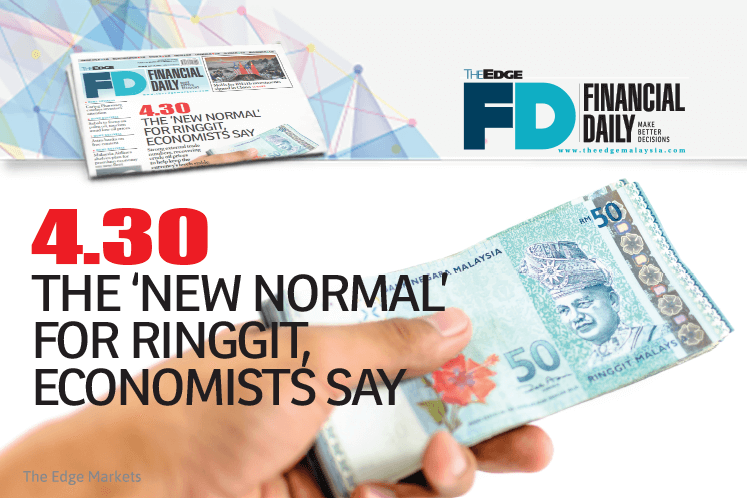
This article first appeared in The Edge Financial Daily on May 15, 2017
KUALA LUMPUR: After being named Asia’s worst-performing currency two years in a row, volatility in the ringgit against the US dollar has stabilised somewhat this year, recovering 3.2% of lost ground year to date.
The local currency underwent a bout of volatility over the past one year against the greenback, trading at a 52-week range of 3.9327 to 4.5002.
Of late, however, the ringgit has been showing signs of stabilising at 4.30, largely influenced by a return of foreign interest to Malaysian government bonds.
In March this year, foreign investors dumped a whopping RM26.2 billion in Malaysian bonds, marking the biggest monthly sell-off since the data was collated by Bank Negara Malaysia (BNM) in 2011.
It is worth noting that the ringgit was trading at 4.4255 during that time (March 31). Last Friday, the ringgit closed at 4.3457, charting a 1.8% gain from March 31.
In a note last Friday, United Overseas Bank (M) Bhd economist Julia Goh said the return of foreign interest in April has aided the ringgit’s stabilisation.
“Foreigners turned net buyers of domestic bonds for the first time in April with an inflow of RM6.8 billion, following five months of selling since November 2016 till March this year totalling RM62.7 billion.
“[This signals] a reversal in sentiment following recent Bank Negara Malaysia liberalisation of bond and foreign exchange measures and more supportive external market conditions,” she said.
Foreign holdings in Malaysian Government Securities for April 2017 were also higher at 39.7%, from 38.5% in March, but still lower than their holdings of 44.7% in February.
Apart from the bond market, economists opine that a new normal of 4.30 against the US dollar for the ringgit could also be supported by both domestic and external factors.
MIDF Amanah Investment Bank Bhd chief economist Dr Kamaruddin Mohd Nor expects the ringgit to trade at levels of 4.30 to 4.35 within the next two months.
“We believe the ringgit will be traded against the US dollar at this range, supported by strong external trade numbers and recovering crude oil prices,” he told The Edge Financial Daily.
Malaysia’s exports increased 24.1% to RM82.6 billion in March from a year earlier on higher sales of crucial products like electrical and electronic goods besides oil palm and crude oil-based items. Brent crude oil prices have been stable, trading at levels of US$50 (RM217) per barrel last Friday compared with levels of US$44 per barrel in November last year.
RHB Research Institute chief economist Lim Chee Sing said the ringgit’s strength has also stemmed from the disparity between US President Donald Trump’s promised reflationary policies and their actual delivery, which had caused a softening bias in the US dollar.
“Domestically, we have the capital inflows into the equity and fixed income market in April, coupled with strong exports, and BNM’s measures which include the conversion of 75% of export proceeds that boosted the ringgit.
“However, should the US Federal Reserve take a hawkish stance in raising interest rates or even in shrinking its US$4.5 trillion balance sheet and if Trump’s policies come [into fruition], then the US dollar could strengthen again,” he said.
ForexTime vice-president of corporate development and market research Jameel Ahmad said the ringgit is attempting a gradual path towards recovery.
“Quite a number of different currencies have regained ground against the US dollar of late. However, the ringgit has benefited from US dollar softness due to how heavily it was sold late last year.
“I still believe that the ringgit is oversold, personally. The fact that the currency is still historically weak is not representative of how the economy is performing in terms of data, which to be honest has been quite impressive,” he added.
TA Securities Holdings Bhd head of research Kaladher Govindan is forecasting the ringgit to average at 4.25 against the US dollar this year.
“We anticipate at least one 25 basis points [hike in overnight policy rate (OPR)] from BNM in the second half of this year. This, along with [stronger] exports and crude oil recovery, as well as net inflows into the equity market could support the ringgit,” he said.
BNM maintained the OPR at 3% last Friday. In a statement, the central bank noted that the ringgit has continued to stabilise, as the banking system liquidity remains sufficient.
“Financial institutions continue to operate with strong capital and liquidity buffers and the growth of financing to the private sector is consistent with the pace of economic activity,” it added.
The ringgit was Asia’s worst performer in 2015 amid a 22% drop in Brent crude and a political scandal involving 1Malaysia Development Bhd.
Last year, the local currency continued to tumble following Trump’s surprise US election victory on Nov 8 and rising US interest rates saw investors take money out of the most liquid emerging markets. BNM’s move to clamp down on non-deliverable forward trades to curb speculative activity on the offshore market also caused some concerns in the currency trade and prompting outflows.